The White House, The Green, Martham
Plus references to the adjoining Granary
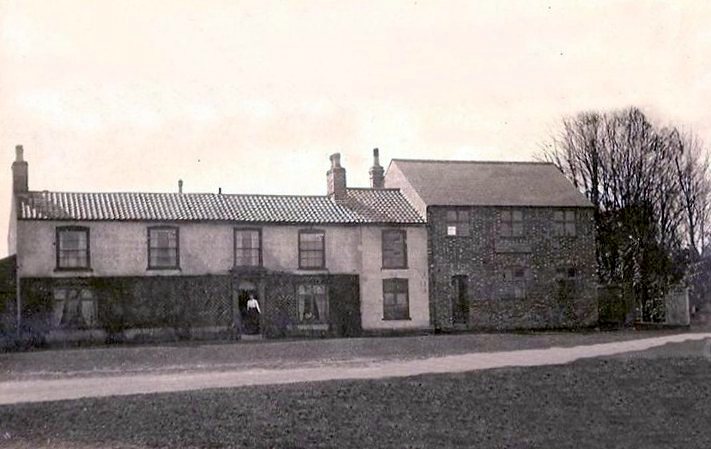
The White House has stood prominently on the south side of the Village Green where residents once stepped straight out onto what was the only road into the village centre from Hemsby long before the present road that dissects The Green existed. The house goes back that far but it is not known exactly when it was built. The earliest record for it appears to be the 1842 Tithe Award map. It is shown on the map as plot 310.
The Tithe Award map was drawn because the Tithe Commutation Act of 1836 required that payments of tithes in the form of farm produce should be replaced by money payments. Tithe was a tax which was paid to the local church. Tithe maps were not particularly drawn up to identify dwellings but still help us trace their history.

In 1842 George Rising (1812-1860) owned the property but it was occupied by George Manship. The barn to the west end of the property was probably built after 1842 because if it was there then it would be a square not coloured in pink. Much, much later the barn was converted into a domestic property called Granary Barn.
The house is unusual in Martham in that its owners never seemed to live there and it was let for long periods to a succession of village vets. This becomes apparent from the will of Stephen Leach (1779-1885). He was a highly successful gentleman farmer and his wife was Rebecca, nee Manship came from the Manship farming dynasty. Under the terms of his Will, Stephen left the White House to his daughter Rebecca (1819-1909) and she was entitled to the income from rents for as long as she lived. Stephen lived and farmed at West Somerton rather than at The White House but instead let it to provide an income. His daughter also does not appear to have lived there. She married Archibald Rowing (1818-1890) who was yet another successful farmer and they lived and farmed at Wicklewood which is about 11 miles west of Wymondham. Rebecca made a will in 1901 and after she died in 1909 her Trustees sold The White House to Mary Thirza Wiseman & and her sister Gertrude. They remained spinsters all their lives and lived with their parents at Grange Farm and Martham House.
1861 & 1871
We can look at the 1861 & 1871 census returns and these confirm the use of the house as the home of the village vet. In 1861 the property was not named but in 1871 it appears to have been known as The Cottage. The Daniels family lived there throughout this time. Robert Daniels was 55 in 1871 and was the head of household and a Veterinary Surgeon born in Wickhampton (a hamlet between Halvergate and Reedham) and his wife Harriet was the same age and from Martham.
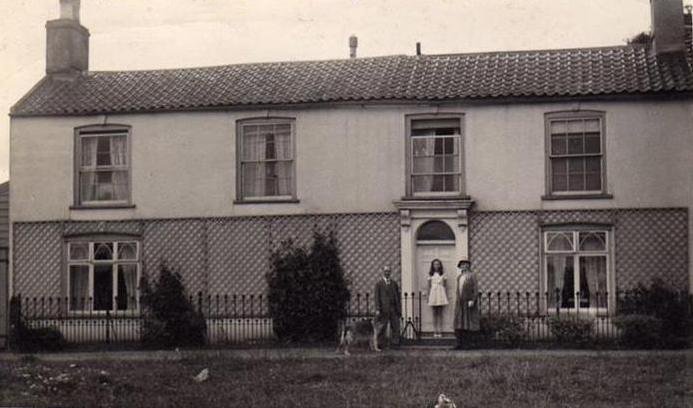
1881
The 1881 census was carried out on 3rd April that year. We cannot be absolutely certain about which entry refers to The White House as individual properties are not named but only listed as “South of the Green” but the most likely is the Smith family. Sydney Smith was 33 and a Veterinary Surgeon. He was born in Rowenden, Kent. His wife was Clara, aged 23, and was born in Martham.
1891
The 1891 census was carried out on 5th April that year. The Golden family lived at The White House at the time. The head of household was Francis Charles Golden who was 27 a Veterinary Surgeon. He was from Dudley, Worcestershire and his wife was Mary V Golden, aged 25, from Sedgley, Staffordshire. They moved away in June 1891.
1901
The 1901 census was carried out on 31st March that year. The use of the house as a vets had come to an end with the Larter family becoming tenants at the property. The head of household was John Larter who was 33 and a plumber & decorator. He was born at Ludham. He was married to Edith, aged 29 and they had two children.
1909
We have seen above that the house was owned by Mrs Rebecca Rowing (1819-1909) up until the time of her death. After she died the house was auctioned by her Trustees and this is the advert that appeared in the Yarmouth Independent on 19th June 1909 for the sale.
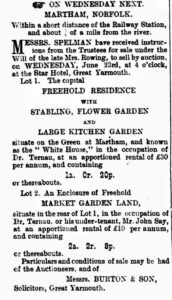
In October 1909 Mary Wiseman and her sister Gertrude purchased The White House from Rebecca Rowing for £500. The Wiseman sisters were the daughters of Alfred & Thirza Wiseman the very successful farmers who lived in a series of the best houses in Martham including Grange Farm and Martham House.
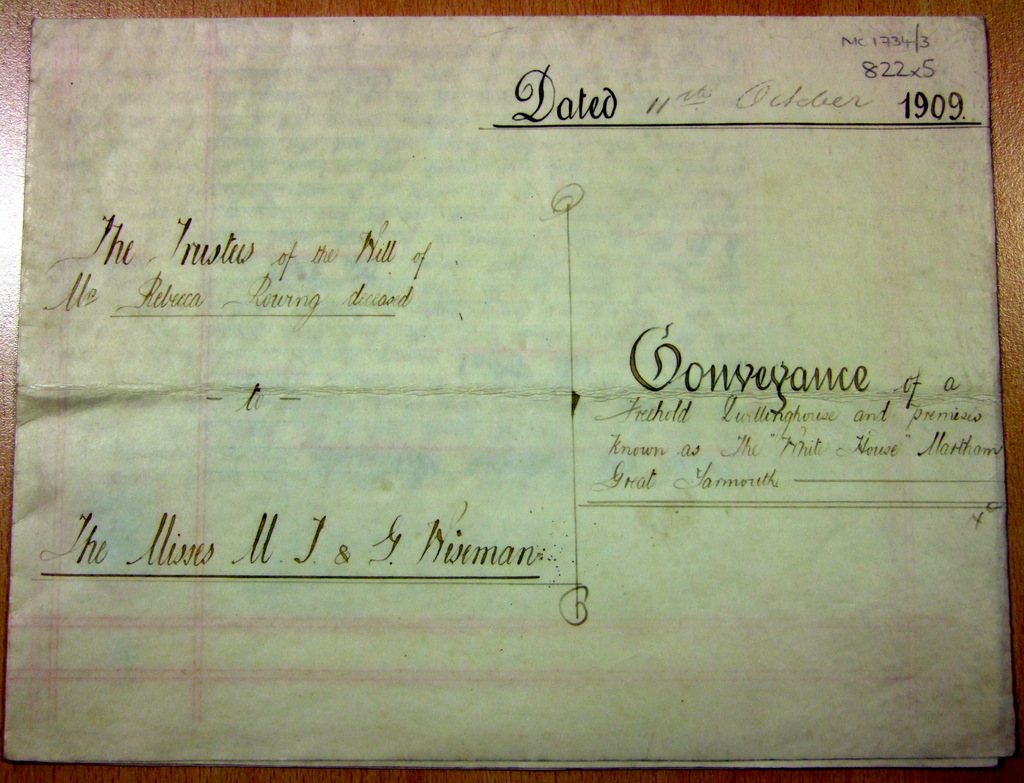
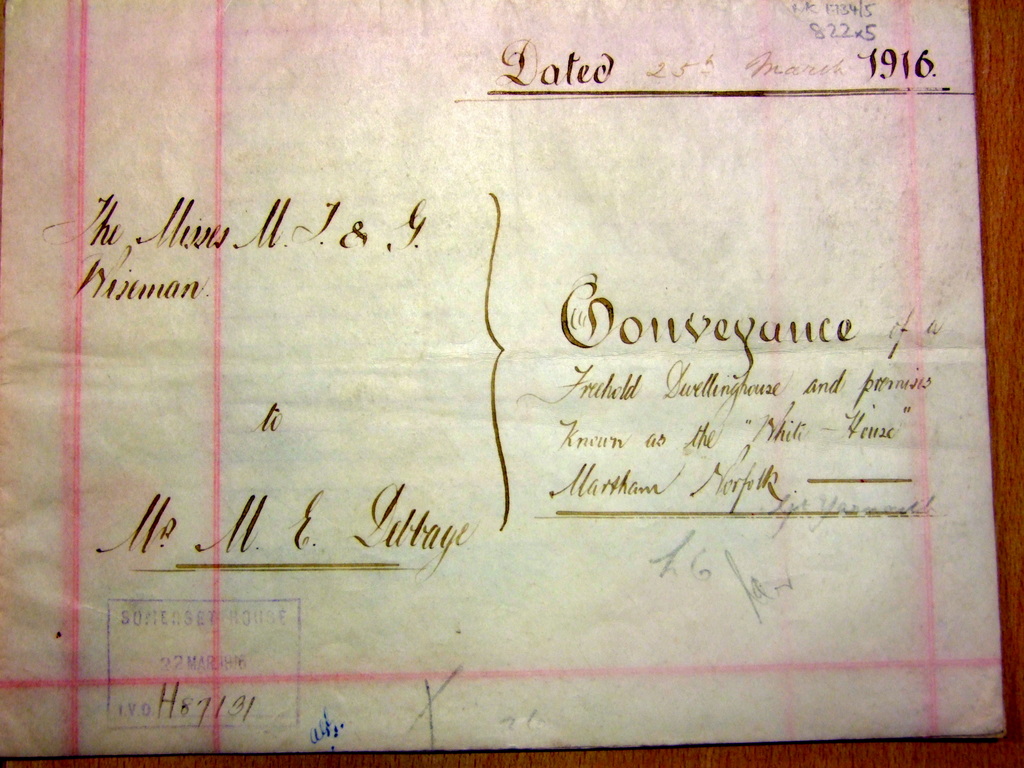
1911
The 1911 census was carried out on 2nd April that year. The Terman family lived at The White House at the time. The head of household was Percival John Whitfield Terman who was 45 and he was a General Medical Practitioner. He was born in Barbados; West Indies and the census says he was a British Subject by his parentage. He was married to Agnes Rosa Terman, aged 43, and they had three servants living in on the night of the census.
In March 1916 the Wiseman sisters sisters sold The White House for £600 to Mary Elizabeth Debbage the wife of Horace who was a corn merchant. Horace died in 1938 and by 1939 Mary had moved to the west side of the village Green where she lived with one of her daughters and a granddaughter.
The White House is listed in the 1939 Register but was unoccupied at the time which was on 29th September 1939.
The next occupiers of the White House were Thomas John Banks and his family, who called him Tom. He was born in Edmonton, London in 1884 and worked as a male nurse in several London mental institutions. By the very end of 1939 or early 1940 he moved out of London with his (second) wife Lily, nee Hall; they had married in 1930 after his first wife, Helen nee Gibson, had died. Tom & Lily had a daughter called Pauline in 1932 and she lived at Martham with them. As the war broke out Tom was still working as a head nurse locally but he may have had retirement on his mind and/or his move to Martham was influenced by the threat of air raids over London. We know this from a wonderful account provided by his niece, Rosemary Kelleher nee Hall, of the time she was evacuated from London to stay with her uncle Tom at the White House in about 1944. Her vivid memories of the time are printed below and give a marvellous account of what it was like to live at the White House at that time. Tom also had five daughters from his first marriage and it seems that some of them also found sanctuary from the bombing of London by living with him in Martham. The White House had about two acres of gardens and Tom used the space as a smallholding raising chickens, ducks, goats and pigs which resulted in some locals giving him the nickname of ‘Porky’. Tom had retired by 1952 and died in 1959. Lily stayed there for a short while but emigrated to Australia in 1963. She died in Australia in 1974 but there is a memorial to her on Tom’s gravestone which stands in St Mary’s graveyard at section I, plot C12.

Rosemary Kelleher, nee Hall, recalls the time she was evacuated from London to the White House in about 1944. She says:-
“My father, William George Hall had a sister named Lily and she was married to Thomas John Banks (my uncle Tom). They lived at The White House during the 2nd World War. During the London air raids I can remember we stayed there with my Uncle & Aunt. They also had various other relatives stay at that time too.
Re the house itself. I remember it as one long white cottage style with a very shallow roof. I remember the room where we were given breakfast of porridge with goats milk on it. The house had a “secret” narrow winding stair going left at the back right of the main room, (believed to be used formerly to reach the servants quarters).
Outside in the garden was an apple orchard (with chain link fence if I remember correctly) to the left of the house and somewhere to the right-hand side of the garden, was a netted off chicken area where I used to sit on the sandy floor and find sea shells. Uncle Tom & Aunt Lily had a daughter named Pauline. I don’t know how old she was but she was much older than me, maybe in her teens or older but I used to eat lots of apples in the orchard and if it was near dinner time, Pauline would come and tell me and once when I was eating an apple, she grabbed it from my hand and threw it back over the fence into the orchard; to me she seemed to be a rather cross person. I am not sure how big the orchard was but it was quite wide and rectangular in shape going from somewhere near the back of the house on the left towards the end of the garden. I suppose you could say that it was a smallholding then during the war years.
Some feet away from the back of the house was an old black pump from which Uncle Tom used to draw water. Most times the water was pumped out, I remember a toad appeared at the pump base. Uncle Tom used to empty an outside toilet of waste. We were not allowed to use an indoor toilet. Perhaps the house was overcrowded with relatives and only the adults could use the indoor toilet.
There was also a pigsty where Uncle Tom kept two pigs. My only memory of them is that one night he took my brother John and I out to feed the pigs in the dark, I remembered the pigs’ eyes glinting red. There was also a tall haystack, it looked like a haystack but I remember being told it was made of pea shucks etc. Ducks used to lay their eggs around the edge at the base of the stack and we were sometimes told to collect them.
One day when my brother John was with us (he wasn’t there all of the time) Uncle Tom got John to climb on the top of this stack via a ladder, then when he was on top, he took the ladder away and my brother began to cry. I thought Uncle Tom was very mean. John used to sleep in the loft, not sure if it was a hay loft separate from the house or in the house itself.
My brother John went to school while he was there but there was no room for me. I used to push a baby around in his pram. His name was Michael Brand a grandson of Uncle Tom from his first marriage. Also, I remember another relative, an older girl than me, probably about 12- 14, not sure what age she was but she was very pretty with long dark hair, her name was Roona.
On my walks pushing the baby around the area I came across a mother cat with kittens. Pauline had warned me that if I found any kittens, I was not to tell Uncle Tom. I was very young, maybe 5 or 6 (I don’t remember the year we were evacuated). Without realising what Uncle Tom would do I told him that I had found some kittens. Pauline was really cross with me and scolded me because she said her father had drowned the kittens. I felt terrible but I was too young to understand why I should not have told him.
Sometimes my mother would visit us and when she did, I slept with her in a bed in the house. One day when she came to visit, I remember seeing her leaving the conservatory where a canary was singing in a cage and I was crying because my mother was leaving.
Some days we would be taken to a local beach, I am not sure if this was Caister or Hemsby.
One day when Uncle Tom collected the apples (must have been Autumn) I remember going with him on the horse and cart to Norwich with the load of apples so they could be made into cider. Another time he took my brother John and me to somewhere on the Norfolk Broads, I don’t remember the journey but remember the reeds and water.
A couple more memories re: the village green in front of The White House, looking out at the green, I remember a corner shop at the far-left hand corner where we used to buy penny bags of crisps with the salt in a twist of dark blue paper.
Uncle Tom had at least two small goats and I was allowed to lead them out to eat the grass on the green. I think they were chained and had stakes put in the ground so they wouldn’t stray. I love goats and apples to this day.
I think I have listed all my memories above and they still haunt me and I would love to visit The White House again to see who lives there now. Also, I wonder if the secret staircase at the back right hand side of the room is still there today, it must have led to the upstairs rooms but I don’t have any recollection of those although I do sometimes have dreams that I am exploring upstairs. I wonder if the present owners have any old maps of the house and garden and location of the orchard and chicken run area and the old black iron pump at the back of the house.
I was hoping that people may remember Tom & Lily Banks. I don’t know when they moved there or how long they had it but it was during the second world war. During the time I was in Norfolk I really loved being there with the chickens, goats and apples even though it was sad being separated from my parents.“
Many thanks Rosemary.